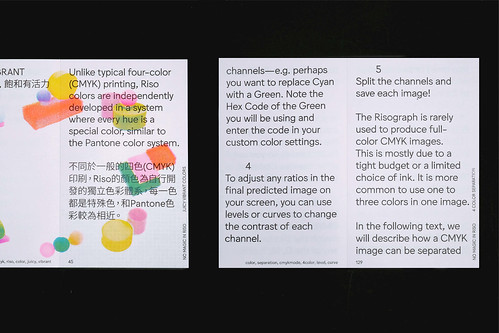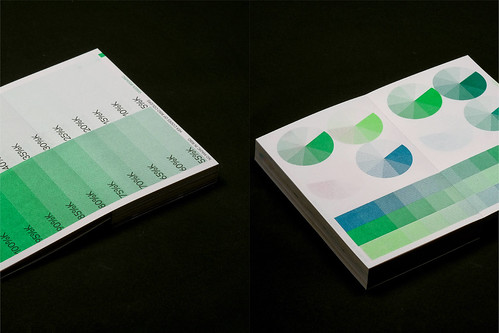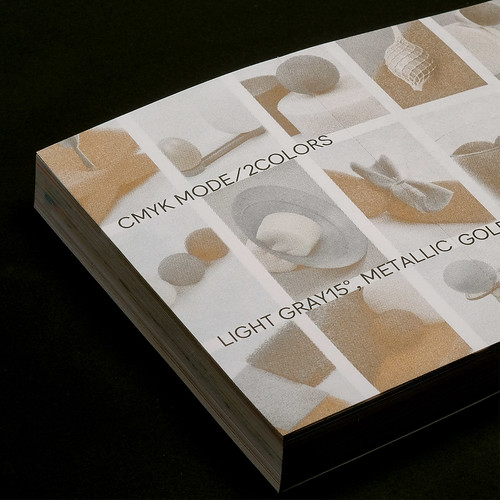Monday, 2:00pm
23 November 2020
Risoholics of the world unite!
A book printed entirely in Risograph technology seeks to share the love of this intriguing printing technique. By Gabriela Matuszyk and Kiki Chang

It took 850 days, 74 tubes of soy ink, fifteen colours, 660 masters, 690,000 sheets of paper, three fans, two digital Riso duplicators and four people to complete this 360-page book that focuses on one thing: the process of Risograph printing, write Gabriela Matuszyk and Kiki Chang.
Designed and produced by Taipei studio O.OO, the publication epitomises the experimental, repetitive and often messy way in which Riso technology reproduces images, through detailed advice on colour separation, halftone and dot formation, and registration. When asked about the motivations behind the book, O.OO said: ‘everyone’s way of experimenting is different, and the book is only trying to offer our experience as a tool.’
Cover (top) and pages from No Magic in Riso – a bi-lingual, no-nonsense, step-by-step guide to Risograph printing.

The title of the book was inspired by Michiel Schuurman’s talk at the ‘Magical Riso’ conference held at the Jan van Eyck Academie in Maastricht in November 2018, a biannual event for ‘risoholics’ from all around the world. During a three-day programme, designers, artists, publishers and printers convened at Risograph workshops, talks, demonstrations and a book fair. (The next is from 1-4 December 2020.)
Surrealist co-founder and poet André Breton once exclaimed: ‘One publishes to find comrades!’* It was during such shared experiences that O.OO came to the realisation that it was the process itself that required further attention and dissemination, as ‘without the participation of people, the technology is plain and void of charm; hence the title No Magic in Riso.’
Colour codes in No Magic in Riso.

O.OO was founded in 2014 by Pip Lu and YuxXan ‘Forty’ Liu, who discovered that Riso printing was not a common practice in Taiwan. The publication was in part an effort to educate and alert the Taiwanese design industry to the potential this technology holds. The book would have not been possible if the studio did not include Risograph printing at the core of its practice. Printed in a limited edition of 1000 and featuring fifteen spot colours, the production involved continuous experimentation and hands-on troubleshooting over more than two years. Filled with scrupulously reproduced imagery and density charts, the book epitomises the Risographic process: ‘Instead of using wordy descriptions, we hope that readers can feel the wonders of Risograph printing through the details of the design in the book: the vibrancy of images, the texture of paper and smell of the ink.’
No Magic in Riso includes practical advice on density charts, colour separation, registration, halftone and dot formation.
Spread featuring images reproduced using two-colour separation (light grey + metallic gold).

The fourth edition of ‘Magical Riso’ takes place via Zoom next week from 1–4 December 2020, 14:30 –17:30 CET (Central European Time). Twenty Riso artists and designers will be interviewed by ‘bibliophile / zinester’ Christopher Kardambikis and the event is again hosted by the Jan van Eyck Academie in Maastricht. Link below.
Gabriela Matuszyk, designer, writer, educator, London
Kiki Chang, graphic designer, Taichung, Taiwan
* This declaration was made by André Breton in 1920, quoted by Gareth Branwyn in Jamming the Media: A Citizen’s Guide Reclaiming The Tools of Communication, Vancouver: Chronicle Books, 1997.
STOP PRESS
To clear some shelving space in our overcrowded warehouse we are making a very special limited offer of Eye bundles. For the next few weeks, while stocks last, you can buy the Eye bundle of numbers 95-98 at an unrepeatable price (UK and Europe only). This is a great present for a work colleague, student designer and anyone who has missed out on these vital, classic issues: the bundle includes the two editorial design specials (76 and 77), the wonderfully eclectic Eye 95, which includeds Matt Willey’s profile of R. O. Blechman and Eye 98, the latest type special.
Eye is the world’s most beautiful and collectable graphic design journal, published quarterly for professional designers, students and anyone interested in critical, informed writing about graphic design and visual culture. It is available from all good design bookshops and online at the Eye shop, where you can buy subscriptions and single issues.


